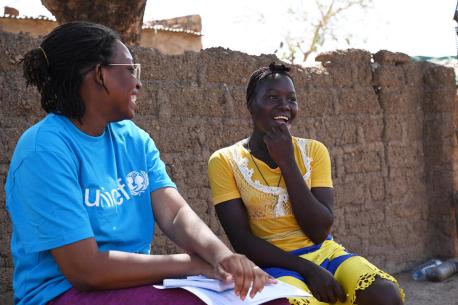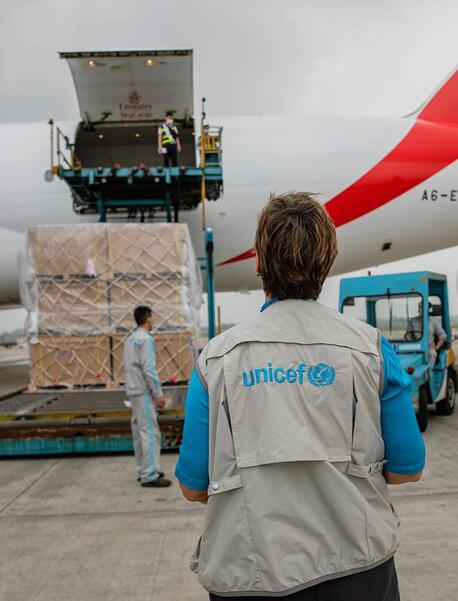
Is an End to Child Marriage Within Reach?
Progress has been made, but at the rate we're going, it will take another 300 years to end child marriage around the world. An urgent call to action.
Economic development, poverty reduction and access to employment and education are key factors in the fight to end child marriage
On May 3, UNICEF launched new global estimates on child marriage. The data are telling a powerful, yet worrisome story.
Girls today are less likely to become child brides than they were 25 years ago. Over this period, 68 million child marriages have been averted. Some regions such as South Asia are making encouraging progress to eliminate this harmful practice. Global progress has been driven predominantly by a decline in India, though this country is still home to the largest number of child brides worldwide.
Progress is also evident in other contexts, including in populous countries where the practice has historically been common, such as Bangladesh and Ethiopia, as well as in smaller countries with lower levels of child marriage that are moving closer to elimination, such as Maldives and Rwanda. The experiences of these countries illustrate that progress is possible in a variety of settings. Still, they tend to share common threads, including improvements in economic development, poverty reduction, access to employment and educational attainment at the secondary level.
In the past 25 years, 68 million child marriages have been averted

Girls from the poorest families are the most vulnerable
But the reality is that we are nowhere near ending child marriage. In fact, when looking at the global average, it will take another 300 years to end child marriage around the world if we proceed at current pace.
Sub-Saharan Africa, which has the second-largest number of child brides globally, has made little progress and is becoming a region of growing concern. Signs of progress are lacking in Latin America and the Caribbean, as well as in parts of the Middle East. And it continues to be the poorest and most marginalized girls who are most at risk and are being left behind. Across all regions, progress in child marriage has primarily benefited girls from the richest families.
Across all regions, progress in child marriage has primarily benefitted girls from the richest families

Conflict, climate shocks and the fallout from COVID-19 threaten to reverse hard-won gains
What’s more, multiple crises, including conflict, climate shocks and the ongoing fallout from COVID-19, are threatening to reverse hard-earned gains. It is estimated that the pandemic has already cut the number of averted child marriages since 2020 by one quarter.
Girls living in fragile settings are twice as likely to become child brides as the average girl globally. For every ten-fold increase in conflict-related deaths, there is a 7 percent increase in the number of child marriages. At the same time, extreme weather events driven by climate change increase a girl's risk, with every 10 percent deviation in rainfall connected to around a 1 percent increase in the prevalence of child marriage.
Addressing economic factors and harmful gender norms can change girls' futures
This trajectory should and can be changed. But it will only happen through investments in inclusive economic growth and gender-responsive social protection; through labor market policies that encourage decent work for women; through investments in quality secondary education; through support to girls who are already married; and by addressing harmful gender norms and unequal power relations.
As we work at the macro-level, we must also continue to work on changing social and gender norms that uphold harmful practices. This includes (among others) targeted life skills, comprehensive sexuality education and livelihood training, and cash and in-kind transfers for schooling, in addition to girl empowerment approaches. All of this must be done within the frame of transforming education, health, social and economic systems to be adolescent- and gender-responsive and increasing accountability and monitoring of national, regional and community child marriage commitments.
As a key response to addressing child marriage, UNICEF works in partnership with UNFPA on the Global Programme to End Child Marriage, the largest global initiative to address child marriage, which is funded by the Governments of Belgium, Canada, Italy, the Netherlands, Norway and the United Kingdom, in addition to the European Union and Zonta International. Through this initiative, we have:
- provided life skills training or comprehensive sexuality education to over 21 million girls across 12 countries
- engaged close to 59 million community members in dialogues on ending child marriage and supporting gender equality
- supported close to 40,000 service delivery points to provide adolescent girl-friendly education, health and protection services
- established partnerships to enhance social protection programs to support girls and their families, advocate for laws and policies that create an enabling environment for change and support research to better understand what works in different contexts to end child marriage in 2022.
Investment in data collection and analysis remains critical
Finally, as countries continue to scale up interventions to eliminate child marriage, investments in data collection and analysis will remain critical. Estimates of the global and regional prevalence of child marriage are based on nationally representative data from over 100 countries. National data on child marriage are primarily drawn from household surveys, including the UNICEF-supported Multiple Indicator Cluster Surveys (MICS) and the USAID-supported Demographic and Health Surveys (DHS). Continued investment in data and statistical capacity at the national level is essential to foster accountability on the part of governments and other stakeholders.
To promote data use in the effort to eliminate child marriage, UNICEF also launched in 2021 the Child Marriage Monitoring Mechanism, a multi-stakeholder initiative which seeks to put forth evidence to hold stakeholders accountable. The Monitoring Mechanism strives to provide easy access to relevant statistical information across several indicators related to child marriage and contribute towards meeting the demand for informed policy and programmatic action.
Now, at the mid-point to the 2030 Sustainable Development Goal deadline to end child marriage, it is time to renew commitments and to redouble efforts. UNICEF will continue to support governments and work in partnership with civil society, academia, and most importantly young people to deliver on this obligation to protect girls from this practice.
Girls should be allowed to be girls — to be children. Today, while reflecting on the new data, we are standing up and saying that this is enough. We need to end child marriage and chart brighter futures for all girls, across the world.
Claudia Cappa is a Senior Advisor for Statistics and Monitoring in UNICEF's Data and Analytics Section. Colleen Murray is a Statistics Specialist in UNICEF's Data and Analytics Section. Nankali Maksud is Senior Advisor in UNICEF's Child Protection Programme Team and is the coordinator of the UNFPA-UNICEF Global Programme to End Child Marriage.
HOW TO HELP
There are many ways to make a difference
War, famine, poverty, natural disasters — threats to the world's children keep coming. But UNICEF won't stop working to keep children healthy and safe.
UNICEF works in over 190 countries and territories — more places than any other children's organization. UNICEF has the world's largest humanitarian warehouse and, when disaster strikes, can get supplies almost anywhere within 72 hours. Constantly innovating, always advocating for a better world for children, UNICEF works to ensure that every child can grow up healthy, educated, protected and respected.
Would you like to help give all children the opportunity to reach their full potential? There are many ways to get involved.





